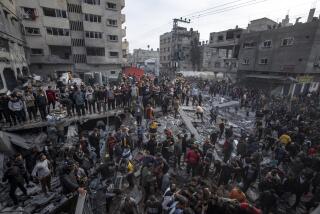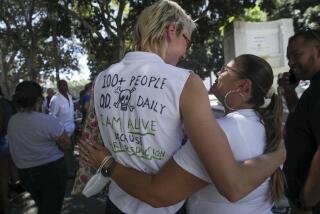Afghan civilian deaths caused by allied forces rise
Reporting from Washington — U.S. and allied forces have failed to reduce the number of civilian fatalities caused by them in Afghanistan despite a two-year effort by American commanders, internal U.S. military statistics show.
Civilian deaths have risen 11% from 144 at this time last year to 160 in 2010. The increase has coincided with the rising number of incidents in which U.S. and NATO attack helicopters mistakenly fired on Afghans who turned out to be civilians, the previously unreleased statistics show.
As U.S. units have pushed into insurgent-dominated areas of southern Afghanistan, they have employed attack helicopters in greater numbers to provide support to troops on the ground, creating more situations in which civilians are inadvertently caught in a clash or mistaken for insurgents, said a senior U.S. official familiar with the statistics.
Only three civilians were mistakenly killed in helicopter attacks in the first 10 months of 2009, but the total through late October of this year is 37, the figures show. The senior U.S. official attributed the increase to using the helicopters in “some very tough fights recently.”
U.S. military officials point out that the number of deaths increased only slightly despite the arrival of tens of thousands of additional American and North Atlantic Treaty Organization troops in Afghanistan.
“This is the only metric that didn’t improve overall between 2009 and 2010,” said the senior official, who spoke on condition of anonymity because he was discussing unreleased statistics.
The statistics were compiled by NATO’s International Security Assistance Force in Kabul, the military command headed by U.S. Gen. David H. Petraeus, and are based on casualty reports generated by ISAF units throughout Afghanistan.
Civilian casualties attributed to NATO forces by other groups, including the United Nations Assistance Mission Afghanistan and Afghan provincial officials, are often higher than those reported by ISAF. For example, the U.N. reported in August that Western forces and their Afghan allies were responsible for one-quarter of the 1,300 civilian deaths, or about 325, in the first six months of this year, with the vast majority of deaths blamed on insurgents.
One of the deadliest incidents involving a mistaken U.S. helicopter attack occurred in February in Oruzgan province. Twenty-three civilians were killed and 12 were wounded, including several women and children, when two U.S. Kiowa Warrior helicopters fired on several vehicles mistakenly believed to be carrying insurgents.
In an incident in August, several rounds fired by a coalition helicopter at insurgents missed their target and struck a building with civilians inside, ISAF officials acknowledged.
The senior U.S. official also noted several encouraging trends, including that the number of Afghans wounded mistakenly by U.S. and other NATO troops had dropped from 296 in the first 10 months of 2009 to 235 this year.
In addition, the number of civilians killed by U.S. and NATO fixed-wing aircraft — fighters and bombers —declined from 54 to 19, a 65% drop, even as the number of airstrikes rose in recent months.
The reduction is consistent with a report by the U.N. Assistance Mission, which said civilian deaths from NATO aerial bombings for the first half of 2010 were down 64% compared with the same period in 2009. The mission’s report, however, said a total of 69 civilians had died in such airstrikes, higher than the military’s tally.
Despite the improving picture in many respects, civilian casualties remain a source of deep tension between the U.S. and Afghan President Hamid Karzai, who has long insisted that Washington do more to reduce the number of incidents.
“Innocent Afghan people should not be the victims in the fight against terrorism,” Karzai said on the anniversary of the Sept. 11 terrorist attacks as he urged coalition forces to do everything they could to prevent civilian deaths.
The total number of incidents in which U.S. or NATO troops have wounded or killed noncombatants has gone down 10% in the last year, from 440 to 395, the statistics show. The number of civilian casualties caused by Taliban and other insurgents has increased by 5%, from 2,845 to 2,990.
U.S. officials complain that Karzai is quick to criticize their mistakes but only occasionally condemns civilian casualties caused by insurgents, even though they are responsible for nearly 90% of all civilians killed or injured, with five times the number of incidents, the U.S. statistics show.
U.S. Army Gen. Stanley A. McChrystal, who was the commander of the International Security Assistance Force until this year, made it a priority to reduce the number of civilian casualties, making protection of the Afghan population a key objective.
McChrystal told his forces to break off engagements with an enemy to avoid accidentally killing noncombatants, and he imposed tight restrictions on when ISAF forces could use lethal force. He issued an order in 2009 that restricted airstrikes if there was a risk of civilian casualties.
He also was quick to apologize after any incident of civilian casualties, sometimes before an investigation was completed. But some U.S. military personnel complained that the rules of engagement — a classified list of rules for when soldiers could fire their weapons — contained too many restrictions.
After Petraeus replaced McChrystal in July, he issued a revised directive. It prohibits ISAF units from firing weapons unless commanders verify that no civilians are present, but it added two exceptions, though neither was made public, to avoid tipping off insurgents.
“We must continue, indeed, redouble, our efforts to reduce the loss of innocent civilian life to an absolute minimum,” Petraeus wrote in the order. He added that such efforts had to be balanced against “our obligation to protect our troops.”
More to Read
Sign up for Essential California
The most important California stories and recommendations in your inbox every morning.
You may occasionally receive promotional content from the Los Angeles Times.











